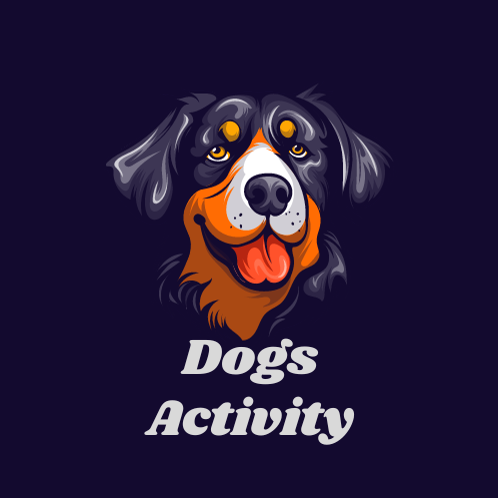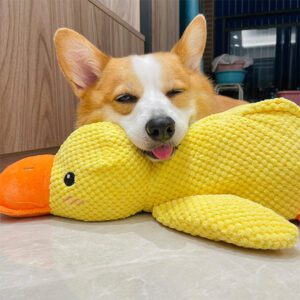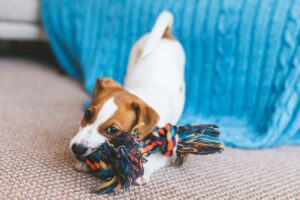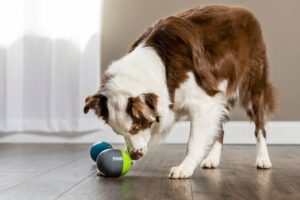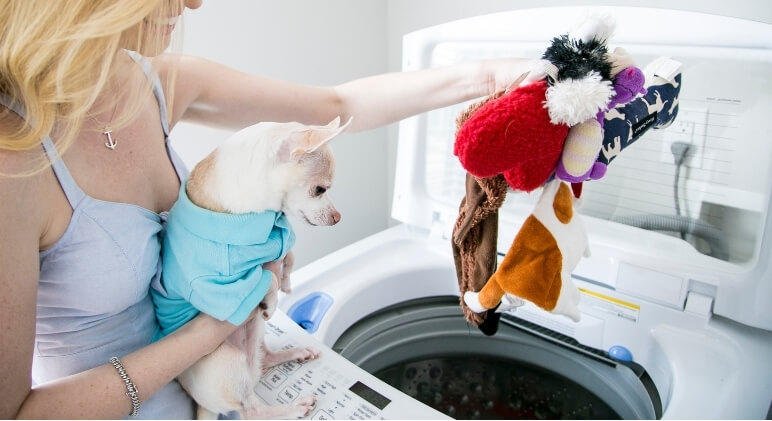
Introduction:
Dogs and their toys share a special bond that goes beyond simple play. A dog’s toys are not just objects; they are companions, comfort objects, and sources of joy. However, with this close relationship comes the need for proper care and maintenance. Regular cleaning of dog toys is essential not only to keep them looking fresh but, more importantly, to ensure the safety and well-being of our furry friends. In this comprehensive guide, we will explore the importance of cleaning dog toys, delve into various types of toys, and provide detailed steps on how to clean them effectively.
Why Cleaning Dog Toys Matters:
- Health and Hygiene:
- Just like any other item that comes into contact with a pet’s mouth, dog toys can harbor bacteria, saliva, and other residues.
- Regular cleaning helps prevent the buildup of germs that can lead to oral health issues and infections.
- Allergen Control:
- Dogs, like humans, can develop allergies. Dust, pollen, and other allergens can accumulate on toys, triggering allergic reactions in sensitive dogs.
- Cleaning toys reduces the risk of allergen exposure and helps keep your dog comfortable.
- Durability and Longevity:
- Regular cleaning can extend the lifespan of dog toys. Dirt and grime can contribute to the deterioration of materials, leading to wear and tear.
- By maintaining cleanliness, you ensure that toys remain in good condition, providing long-lasting entertainment for your pup.
- Preventing Unpleasant Odors:
- Over time, dog toys can develop unpleasant odors due to saliva, dirt, and other contaminants.
- Cleaning eliminates odors, creating a more pleasant environment for both you and your furry companion.
Different Types of Dog Toys and Cleaning Considerations:
Understanding the various types of dog toys is crucial when it comes to cleaning, as different materials and structures require specific cleaning approaches. Here are common types of dog toys and how to clean them effectively:
1. Plush and Stuffed Toys:
- Cleaning Method:
- Check for any loose parts or damage that may pose a choking hazard. Repair or discard damaged toys.
- For machine-washable toys, place them in a pillowcase or mesh laundry bag to protect them during washing.
- Use a mild detergent and wash on a gentle cycle. Ensure all detergent is rinsed out thoroughly.
- Air-dry the toys completely before returning them to your pup.
2. Rubber and Chew Toys:
- Cleaning Method:
- Inspect the toy for any signs of wear, cracks, or breakage. Discard damaged toys promptly.
- For solid rubber toys, wash them with mild soap and water. Use a brush to scrub away any residue.
- Some rubber toys are dishwasher-safe. Check the manufacturer’s instructions and place them on the top rack.
- Freeze rubber toys filled with treats or peanut butter for a refreshing and engaging activity.
3. Rope Toys:
- Cleaning Method:
- Remove any loose threads or frayed ends that could pose a choking risk.
- Hand wash rope toys with mild soap and warm water. Squeeze out excess water.
- If the toy is machine washable, secure it inside a pillowcase or laundry bag and wash on a gentle cycle.
- Allow rope toys to air-dry thoroughly to prevent mold growth.
4. Interactive and Puzzle Toys:
- Cleaning Method:
- Disassemble the toy according to the manufacturer’s instructions.
- Wash each component separately using mild soap and warm water.
- Use a small brush or toothbrush to clean intricate parts and hard-to-reach areas.
- Allow all parts to dry completely before reassembling the toy.
5. Squeaky Toys:
- Cleaning Method:
- Check the toy for any punctures or damage that may compromise the squeaker. Discard damaged toys.
- Hand wash with mild soap and water. Squeeze the toy to allow the soapy water to reach the squeaker.
- Rinse thoroughly to remove all soap residue.
- Ensure the toy is completely dry, especially around the squeaker, to prevent mold growth.
6. Hard Plastic Toys:
- Cleaning Method:
- Inspect for cracks, sharp edges, or other damage. Discard toys that cannot be repaired.
- Wash hard plastic toys with warm soapy water using a sponge or brush.
- Rinse thoroughly to remove soap residue.
- Sanitize plastic toys by soaking them in a solution of one part white vinegar to one part water for 10-15 minutes. Rinse well.
7. Natural and Edible Chews:
- Cleaning Method:
- Inspect the chew for any small or sharp pieces that may pose a choking hazard.
- Some natural chews, like bully sticks, are single-use and do not require cleaning.
- For reusable chews, wash them with mild soap and warm water. Soak in a pet-safe disinfectant if necessary.
8. Vinyl and Latex Toys:
- Cleaning Method:
- Examine for any signs of wear, including peeling or small pieces breaking off. Discard damaged toys.
- Wash with mild soap and water. Use a soft brush to clean crevices.
- Rinse thoroughly and allow the toy to air-dry completely.
Step-by-Step Guide: How to Clean Dog Toys:
Now that we’ve explored the cleaning considerations for different types of dog toys, let’s break down the step-by-step process to ensure a thorough and effective cleaning routine:
Step 1: Inspection:
- Before cleaning, carefully inspect each toy for signs of damage, including loose parts, sharp edges, or cracks.
- Discard any toys that are beyond repair or that pose a potential safety risk to your dog.
Step 2: Categorization:
- Group toys based on their material and structure. Plush toys may require a different cleaning approach than rubber or plastic toys.
- This categorization helps streamline the cleaning process and ensures that each type of toy receives the appropriate care.
Step 3: Pre-Cleaning:
- For toys with loose threads or frayed ends, trim them carefully to prevent further unraveling.
- Shake out or vacuum plush toys to remove loose dirt and debris before washing.
Step 4: Washing:
- Follow the specific cleaning methods outlined for each type of toy.
- Use mild soap or pet-safe detergents to avoid any potential harm to your dog.
- If machine-washing, use a gentle cycle and place toys in a protective bag or pillowcase to prevent damage.
Step 5: Disinfecting:
- Consider disinfecting toys, especially those that your dog frequently mouths or chews.
- For plastic toys, a solution of white vinegar and water works well. Soak toys for 10-15 minutes before rinsing thoroughly.
Step 6: Drying:
- Allow toys to air-dry completely before returning them to your dog. Ensure they are thoroughly dry to prevent mold growth.
- Plush toys may take longer to dry, so place them in a well-ventilated area or use a fan to speed up the process.
Step 7: Rotation:
- Consider having a rotation of toys to minimize wear and tear. This not only extends the life of the toys but also keeps your dog engaged with a variety of options.
- Regularly assess your dog’s toys and replace any that are excessively worn or damaged.
Tips for Cleaning Dog Toys:
- Frequency Matters:
- Establish a regular cleaning routine for your dog’s toys. The frequency will depend on factors such as how often your dog plays with them and the type of toys.
- Use Pet-Safe Products:
- When choosing cleaning products, opt for those specifically formulated for pets. Harsh chemicals or strong fragrances may be harmful to dogs.
- Inspect for Wear and Tear:
- Regularly check your dog’s toys for signs of wear and tear. Promptly discard any damaged toys to prevent potential choking hazards or injuries.
- Consider Your Dog’s Health:
- If your dog has specific health concerns or allergies, choose cleaning products and detergents that align with their needs.
- Rotate Toys:
- Keep a rotation of toys to maintain your dog’s interest and prevent boredom. This also allows you to clean a subset of toys while others are in use.
- Dishwasher-Safe Toys:
- Check the manufacturer’s instructions to see if certain toys are dishwasher-safe. This can be a convenient and effective way to clean hard plastic toys.
- Supervise Chewing:
- Always supervise your dog when they are chewing on toys, especially those with edible components. Monitor for any signs of choking or digestive issues.
- Storing Clean Toys:
- Store clean toys in a designated area, away from areas prone to dirt and dust. Consider using a toy basket or bin to keep them organized.
Conclusion:
Ensuring that your dog’s toys are clean and well-maintained is a fundamental aspect of responsible pet ownership. It not only contributes to your dog’s health and hygiene but also enhances their overall well-being and enjoyment of playtime.
By understanding the different types of dog toys and employing appropriate cleaning methods, you can create a safe and engaging environment for your furry friend. A clean toy not only keeps your dog happy but also strengthens the unique bond between humans and their canine companions, fostering a relationship built on care, love, and the joy of shared play.
